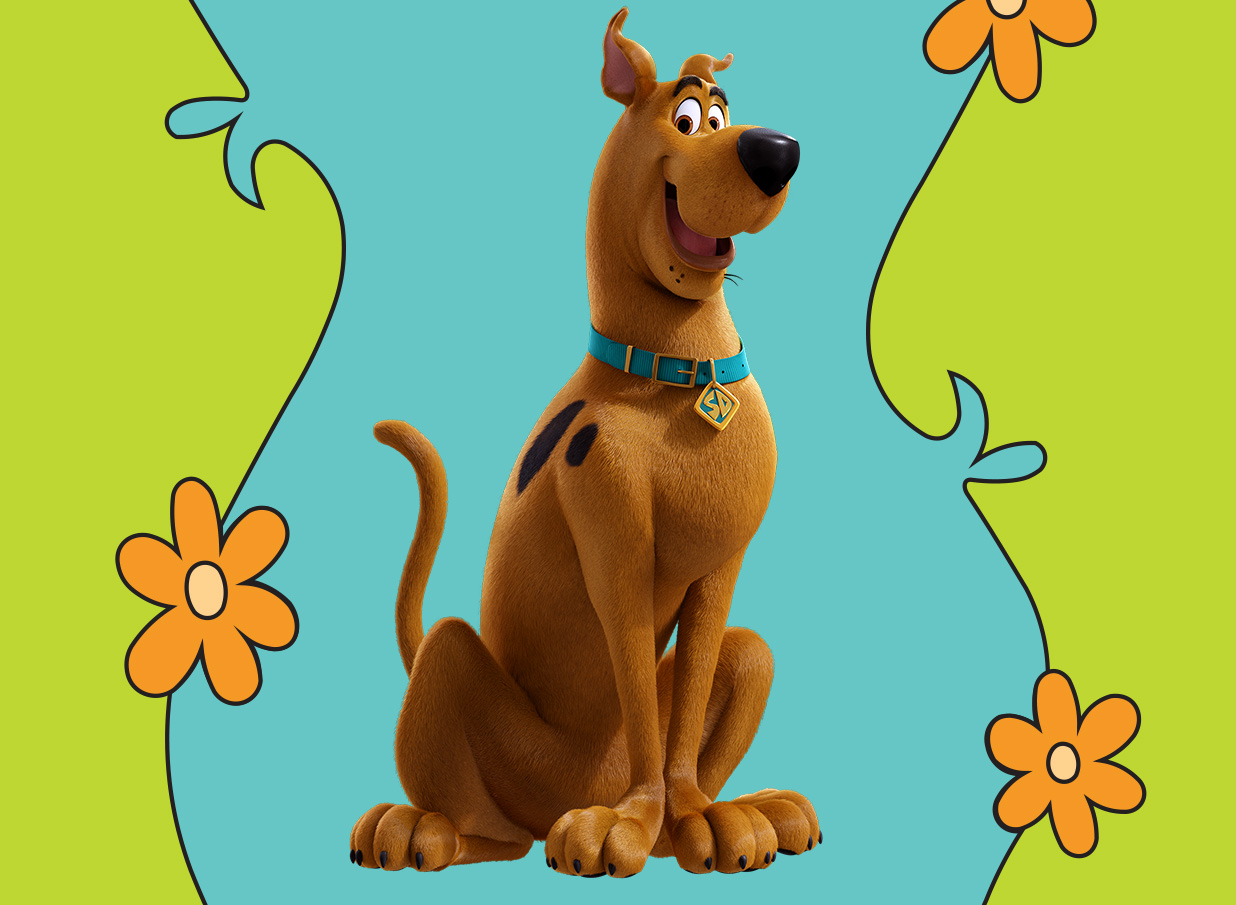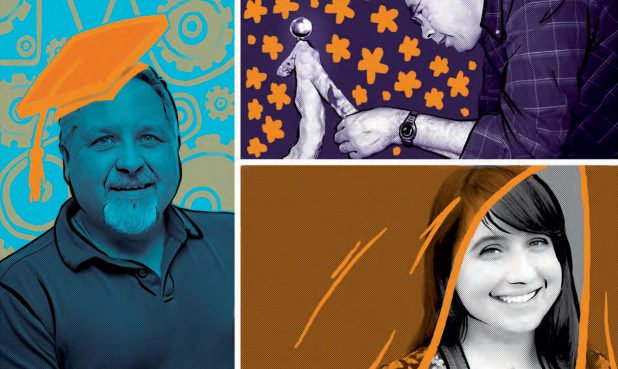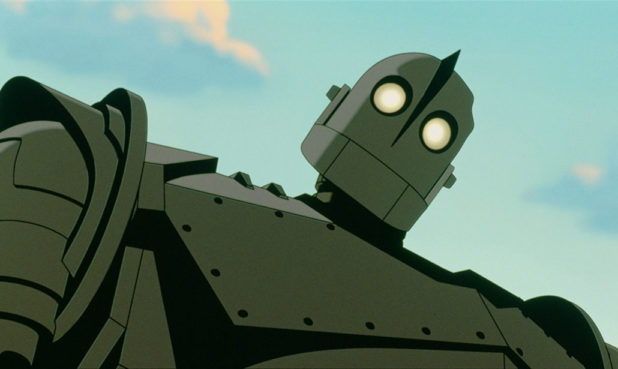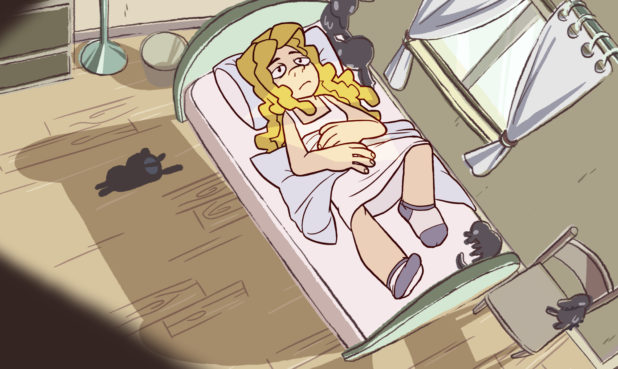In the late 1960s, parents watch groups were protesting the extreme violence in children’s cartoons. This resulted in a number of shows going off the air and a need to fill slots. CBS daytime programming executive Fred Silverman approached William Hanna and Joe Barbera—the powerhouses behind The Flintstones and The Jetsons—and the threesome came up with a basic concept: A cartoon featuring teens in a band, like The Archies, who solved mysteries between gigs. Throw in a dog, and the pitch was ready. But CBS execs in New York turned it down, saying the artwork was too scary.
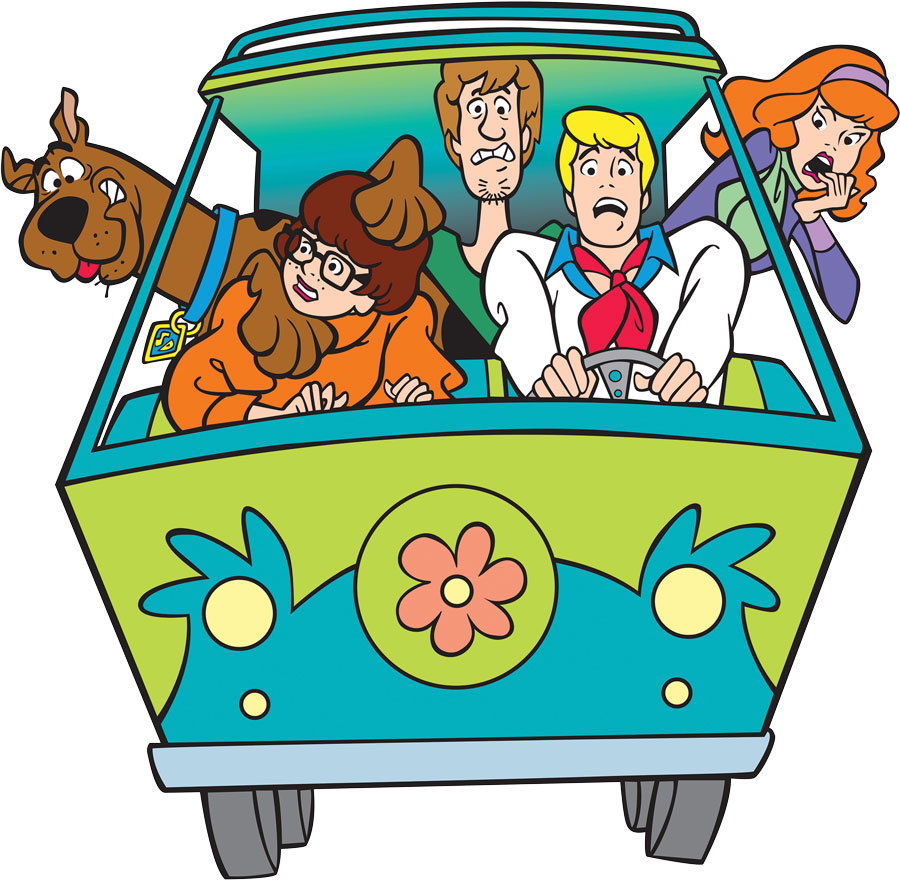 Carlos Cardetas / Alamy Stock Photo
Carlos Cardetas / Alamy Stock PhotoThe story of Silverman taking a red-eye back to L.A., stressed out because this new show was supposed to anchor his Saturday morning lineup, is now legend. As the plane began to land, Frank Sinatra’s “Strangers in the Night” came over the speakers. The song ended with a scat, “dooby-dooby-doo,” and the lightbulb went on. Bring the dog forward, name him Scooby-Doo and reshape the concept toward Abbott and Costello Meet Frankenstein. Comedy and horror in a single cartoon.
Enter writers Joe Ruby and Ken Spears, who developed the storylines, and renowned animator Iwao Takamoto, who designed a bow-legged Great Dane. With the mystery of how to make this show work now solved by Fred, his gang and their loveable dog, the suits in New York bought it. Scooby-Doo, Where Are You? debuted in the fall of 1969.
The original series has been followed by more than a dozen rebooted series, as well as a wide variety of Direct-to-TV movies. Over the decades Scooby-Doo moved from CBS to ABC to Kids’ WB to Cartoon Network to Boomerang. Silverman, Hanna, Barbera, Ruby, Spears and Takamoto were often along for this ride from studio to studio, and through it all, an overflowing stream of artists and animators made sure that “those meddling kids” and a cowardly canine continued to unmask villains and save the day. But what makes Scooby-Doo appeal to audiences across the decades?
Memorable & Creepy
A member of the talented team that shaped the original Scooby Doo, Where Are You?, background artist Eric Semones came to Hanna-Barbera fresh out of the Navy. “In 1964, I had wound up on a destroyer in the South China Sea during the Gulf of Tonkin incident in Vietnam,” he says. “We would get movies like The Longest Day and Cleopatra from one of the supply ships. We always traded them for any of the Looney Tunes we could get. We loved the cartoons, and there was a name on the titles that stuck with me. Paul Julian.”

When Semones was discharged in 1966, he applied for a job at Hanna-Barbera. The next thing he knew, he was working on The Flintstones and Josie and the Pussycats. A few years later he was brought in to paint backgrounds for a new show called Scooby-Doo, Where Are You?
By this time Paul Julian—the man whose work had captured Semones’ attention on a Navy destroyer—was freelancing for Hanna-Barbera. Semones says, “Paul was like a flytrap. People would come from all over the building to see what he had brought in because it was stunning. I was this 22-year-old shy kid, and I was looking at this stuff, and I didn’t want to make any noise. I just wanted to sit and study it. When I saw his work, I thought, man, I’ve got to put the pedal to the metal if I’m going to get anywhere in this industry.”
With the bar set, Semones used Scooby-Doo, Where Are You? to develop his craft, contributing to the show’s gothic, creepy backgrounds—some of the most evocative and memorable in cartoon history. “Scooby-Doo gave me an opportunity to stretch,” Semones explains. “There were some scenes where Paul would set the style, and it was really like a master’s degree in fine arts.”
As for what makes Scooby-Doo still appealing after fifty years, Semones says, “The characters are funny, the writers use topical humor, and everyone likes a good whodunit.”
Facing Your Fears
For background painter Tristin Cole, “What I love most about working on Scooby-Doo is that it’s almost genetic for me. I watched my father [Corny Cole], who was a background painter for Hanna-Barbera, paint backgrounds for Scooby when I was growing up. He introduced me to Iwao Takamoto when I was eight years old, and imparted in me the great sense of respect he had for Iwao.”
Cole has worked on nearly 20 Scooby-Doo Direct-to-TV movies and more than 100 TV episodes. She’s currently on Scooby-Doo and Guess Who? and says that even now, “When you mention Scooby to people their eyes light up, and it triggers a childhood memory.”
Cole feels one reason the show maintains such a firm grip on the imagination is the continuity in the backgrounds with “a certain design and color language that was established early on.” She adds, “Iwao gave me some words of wisdom about painting Scooby. He said if you’re painting an exterior house or building, paint the windows dark, with no lights on. It automatically makes it feel haunted or spooky and in the world of Scooby.”
As for what makes Scooby-Doo still appealing after 50 years, Cole says, “Familiarity. I think people look forward to hearing Shaggy say ‘zoinks!’ or the villain say, ‘If it weren’t for you meddling kids!’ There’s also the fact that the villain is unmasked at the end. It lets kids know that the monsters in the story aren’t real. And when Scooby or Shaggy get scared, they face their fears and end up solving the mystery or saving the day. There is a positive lesson in that.”
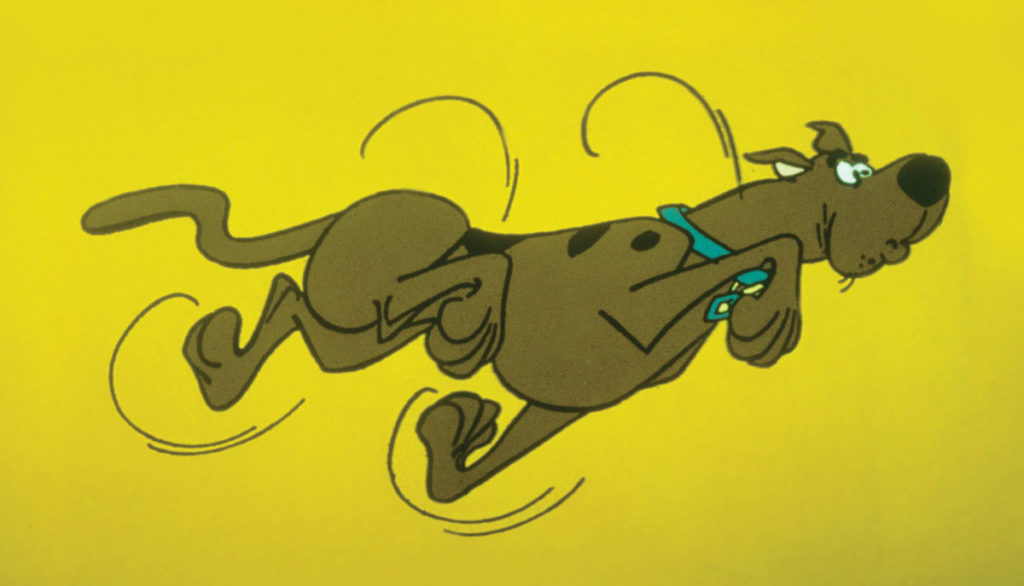
“They love that damn dog.”
Layout artist Susan Crossley and husband, Animation Director Tim Walker, have enjoyed separate successful animation careers filled with Scooby-Doo projects. A graduate from art school in the early 1970s, Crossley learned that Hanna-Barbera was looking for people who could draw figures. But she was told, “‘We can’t bring you in right away.’ Another couple days after that, they said, ‘Well, you’re welcome to join the ink and paint ladies.’ I said, ‘No. You told me I was coming in at this studio, and that’s what I’m going to do.’ So that’s what I did. I got myself in. I made it happen.”
“Susan made a life for herself,” Walker adds. “Nobody sat down with her when she came in fresh off the street. She was thrown into the deep end and she came to the surface and made a career for herself.”
“It was hard sometimes,” Susan continues, “not having more women around. And I was always nervous. I was a perfectionist in a way, and I was always like, “Oh God, I hope I make it,” especially since Scooby was a little hard to draw. He was all angles, and Iwao Takamoto had to go over our drawings.”
-

Iwao Takamoto, Animation Producer and Gary Johnson, North America Operations of Hanna Barbera Enterprises go over design concept of Scooby-Doo tennis shoe (1976) -
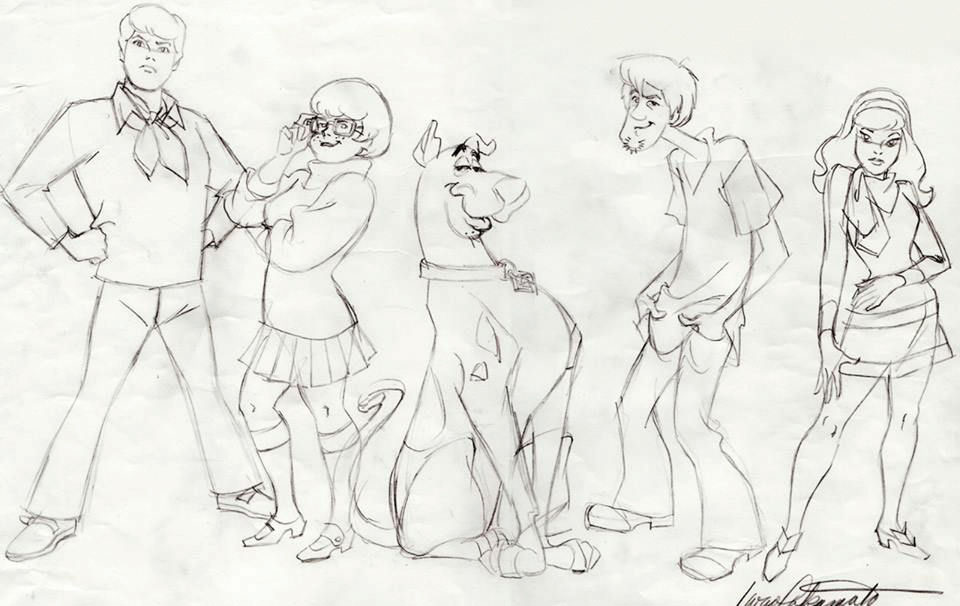
Original Scooby-Doo, Where are you? sketch by Iwao Takamoto -

Creative team Joe Ruby, Ken Spears, Spike Brandt, Tony Cervone and Eric Semones worked together on several DTV Scooby-Doo films
Takamoto drew the exact opposite, bowing Scooby’s legs, enlarging his feet and sloping his hindquarters. This goofiness is fun for kids to watch, but as Walker says, “That dog is not designed for animation. Animation is circles and ovals and things like that. Things you can move around and squash and stretch. Scooby had so many hard lines.”
Like Crossley, Walker graduated from art school, but he knew even at four or five that he was going to be an animator, and later, when a neighbor told him where the Hanna-Barbera studios were located, he realized it wasn’t far from his middle school. “I had the bright idea to ride down there one Saturday. I lifted up the trashcan lid, and there were cells and backgrounds everywhere,” he says. “That started a good ten years of dumpster diving. I had backgrounds and hand-inked cells. Beautiful.”
It was only natural that Walker would wind up at Hanna-Barbera, with one of his first jobs freelancing for Ed Love, an animator on the original Scooby-Doo, Where Are You? Throughout Walker’s career he worked for every studio in town, but he often returned to Scooby-Doo because, he explains, “By far I had the most fun working at Hanna-Barbera. To me it was like, I’m working for my idols. Bill and Joe. Jiminy Christmas, you want to pay me to come in here and do this. I spent 50 years living my dream. Who can say that?”
As for what makes Scooby-Doo still appealing after all these years, Crossley says, “That voice. It’s fun for kids to talk like Scooby-Doo.” Walker adds, “They just love that damn dog!”
Crossing Cultural Boarders
Scooby-Doo was an integral part of storyboard artist Aluir Amancio’s childhood in Brazil. “I would sit every day in front of the TV, and I would try to draw my favorite characters. I drew Scooby-Doo plus all the others. That’s how I became familiar with the Hanna-Barbera style.”
“Sometimes when I’m working, I forget I’m not drawing for fun. Then I stop and go, I’m drawing Scooby-Doo!”—Aluir Amanico
At 10, Amancio was approached by the owner of a cartoon studio. “He told me, ‘We can’t hire you right now because you’re too young. But what if you show up in the studio and start learning with professionals as a trainee. That’s what I did. I remember one day I showed him my Hanna-Barbera drawings. He laughed and said, ‘You know Aluir, you draw Hanna-Barbera characters better than you draw mine.”
Amancio’s passion turned into a profession, and in 1998, when he was working in Brazil for Warner Bros. on Batman Beyond, he was brought to California. “My first assignment for Scooby-Doo came right in the middle of my move,” he says. “I did my whole storyboard section in a hotel room. It was quite a challenge.”
Along with working as a storyboard artist on more than 10 Scooby-Doo Direct-to-TV movies and Scooby-Doo! Mystery Incorporated, Amancio also draws for DC comics. But his heart belongs to Scooby: “I love the style. Sometimes when I’m working, I forget I’m not drawing for fun. Then I stop and go, I’m drawing Scooby-Doo!”
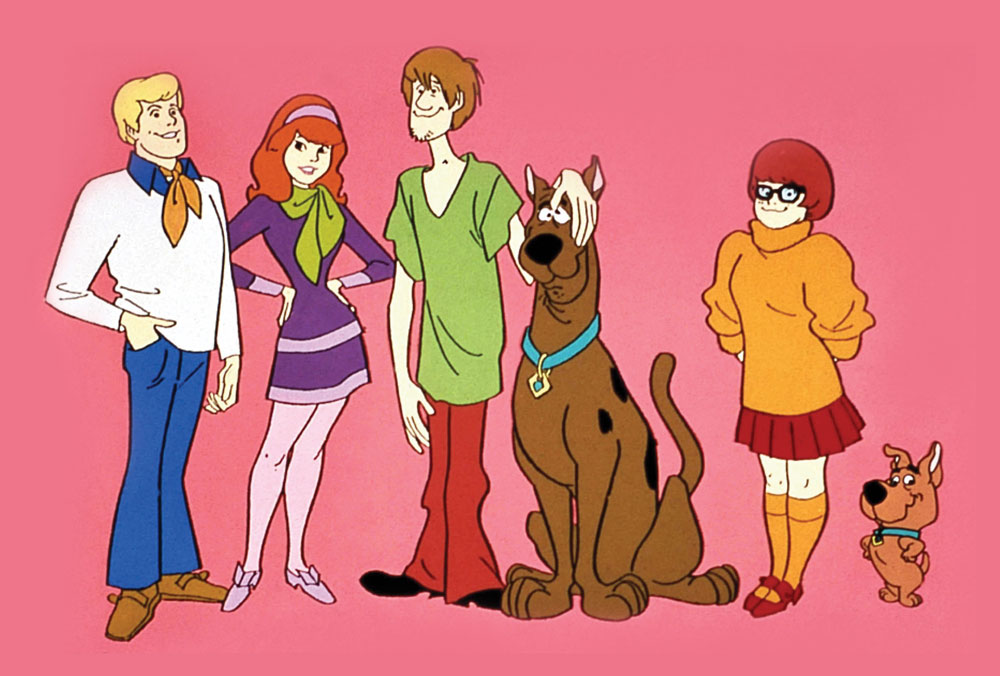
Experimentation has its risks.
Zac Moncrief was the supervising director on an adult show for Comedy Central when he was approached by executives at Warner Bros. in late 2013. “They informed me that they were looking to do a more comedy-driven version of Scooby-Doo, and wondered if I’d like to bring the experience I had directing on Phineas and Ferb to this new show,” he says.
For Be Cool, Scooby-Doo!, one of the more recent series in the franchise, Moncrief and his team played around with the familiar characters and “were able to broaden the scope of who they really are. The comedic approach I wanted to explore was more from character and the writing than from a broad visual style. I truly enjoyed diving in and creating engines that drove these characters, all starting from the nuggets of what we knew about each one from past series.”
This kind of experimentation, though, has its risks. Moncrief explains, “Familiarity plays a huge part, especially in something as universally known and loved as Scooby-Doo. I am so proud of the amount of true, diehard fans that finally gave this version a chance, and were able to see, and really enjoy, what we were trying to do. Once we won over the diehards, I knew that what we were doing was working. That’s rewarding.”
“Scooby and the gang represent all that we are as human beings,” he says. “Scooby and Shaggy are that inner voice that tells us something is off. And Fred, Daphne and Velma represent the other side of humanity that inevitability wants to get to the bottom of that injustice and make it right again. It’s why Scooby will always be relevant and why it will always have an audience.”
A Scooby-Doo Purist
Prop designer Mark Bachand estimates that he’s spent about one-third of his 25-year animation career working on Scooby-Doo projects, including seven Direct-to-TV movies and three series: What’s New, Scooby-Doo?, Scooby-Doo! Mystery Incorporated and the current Scooby-Doo and Guess Who? While his Scooby journey began in the late 1990s, his work experiences were steeped in the show’s origins.
For the first Direct-to-TV movie Bachand worked on, he says, “[Producer] Scott Jeralds was instrumental in bringing Iwao back to the property. They were friends
at Hanna-Barbera, and Scott said, ‘Iwao’s absolutely gotta be on this. He’s the original designer. He knows the characters inside and out.’ I’ve worked on a number of other projects that you realize are very special, but it makes it more so when you’re working with the creative forces behind it.”
Another time, on “Scooby-Doo and the Legend of the Vampire,” Bachand remembers how Jeralds and character designer Scott Awley “thought it would be a great idea if they could get all the original Scooby voice actors together, with the exception of Don Messick who had passed by that time. Along with Nicole Jaffe as Velma, Heather North as Daphne and Frank Welker voicing Scooby and Fred (who he continues to voice to this day), acclaimed Top 40 DJ Casey Kasem returned as Shaggy, and “it really did affect the chemistry.”
While Bachand might be considered a Scooby-Doo purist, he has enjoyed his moments of adding something new to the franchise. “I remember one Direct-to-TV we were working on,” he says. “We had to go inside the Mystery Machine, and I was told, ‘You gotta design it.’ This had never been done in the original series, so we had to do it from scratch. That was a lot of fun.”
“I think it’s the chemistry and the relationships of the characters, because they really care for each other. There’s nothing snarky or undercutting in their personalities,” says Bachand of Scooby’s enduring appeal. “They’re very genuine toward each other. I think a lot of people just long for that. To be talked to and treated in that caring manner.”
Hitting the Big Screen
Fifty years after his television birth, Scooby-Doo will finally hit the big screen as an animated feature film, Scoob! This first-of-its-kind project is being helmed by director Tony Cervone, who honed his Scooby skills as Supervising Producer on Scooby-Doo! Mystery Incorporated and producer/director on several Scooby-Doo Direct-to-TV movies.

Unlike many others who arrived eagerly in the world of Scooby-Doo, Cervone was a reluctant convert. He was a Looney Tunes stalwart when former Cartoon Network VP Sam Register came to him and asked, “Do you want to do a Scooby-Doo thing?”
Cervone’s immediate response: “No, I don’t do Scooby-Doo, I do Looney Tunes stuff.” Sam said, ‘That’s crazy because it’s everything you love. You gotta do it, just do one.’ That was a decade ago.”
Cervone still works on Looney Tunes projects, but as he explains, “They’re very different in terms of the spirit behind them. I love the Warner Bros. Looney Tunes stuff and I love the Hanna-Barbera stuff. The difference is, the Hanna-Barbera stuff is much more personal. I can’t separate myself from the people who created it, and because it is more personal, I do kind of treat it a little differently.”
 Courtesy of Warner Bros.
Courtesy of Warner Bros. In taking Scooby and the gang to the big screen, Cervone says, “The biggest challenge is being true to who the original characters are and keeping their DNA fully intact, but also doing something new and original with it because we can’t always do the same thing over and over again. We love these characters, and we want to honor them. And we love the people who made these characters. I don’t want to disappoint them.” Going a step further, Cervone and his team have peppered the movie with small tributes, and Scooby fans in-the-know should keep their eye out for Easter eggs like a bowling alley called Takamoto Bowl, after Iwao Takamoto.
 Courtesy of Warner Bros.
Courtesy of Warner Bros. Scoob! will be a complete origins story—another first for Scooby and the gang. It will also benefit from the production schedule and technology of feature quality animation. At the same time, Cervone intends “to keep the core the same. For me the most important thing with Scooby-Doo is the friendship within the gang, especially with Scooby and Shaggy. That’s the fire that keeps things burning. I love the mysteries, and I love the monsters, but without feeling the Scooby and Shagginess of it, it falls flat to me. Those guys are the best example we can make of the power of friendship. We get changes thrown at us throughout our whole lives, but some friendships can withstand any change that happens. That’s the kind of friendship Scooby and Shaggy have.”
 Courtesy of Warner Bros.
Courtesy of Warner Bros. “The biggest challenge is being true to who the original characters are and keeping their DNA fully intact, but also doing something new and original with it.”—Tony Cervone
A Collective Respect
Rare is the person who worked on Scooby-Doo who didn’t cross paths with storyboard and layout artist Jerry Eisenberg, a member of the original team that, along with Iwao Takamoto, developed Scooby-Doo, Where Are You? While Iwao is the famed creative force behind Scooby, Eisenberg remembers helping design Shaggy because “I was doing characters with extra-long necks once in a while.”
Eisenberg was busy supervising layouts on other cartoons when Scooby went into production, but his memories capture how this longstanding favorite was a result of more than just the work done by those listed on the shows’ IMDB pages. “Back then we could interface with the writers, the background painters, whoever. Joe [Barbera] was always available. I miss the camaraderie and teamwork we had for many years, working in such close proximity.”
Eisenberg brought his expertise to numerous Scooby-Doo TV episodes and DTV movies in the 2000s, and he is universally praised by those who have worked with him. Although the way in which animation departments operate may not be as intimate anymore, the spirit Eisenberg describes lives on through a legacy of collective respect and care for Scooby and the gang.
